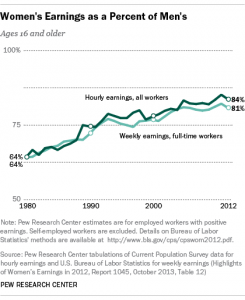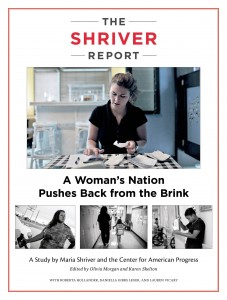Fifty years ago, the United States adopted the Civil Rights Act, prohibiting discrimination on the basis of race, ethnic origin, religion, and gender. Women were a last-minute addition to the bill, and some legislators actually hoped that adding women would mobilize enough opposition to kill the entire act. But the court cases and public demonstrations that the Civil Rights Act enabled women to organize dramatically changed their status in the United States. We can assess the tremendous progress that has been made by comparing current figures to those collected the year before the passage of the act and published in the 1963 report of the President’s Commission on the Status of Women.
Leadership and occupations. In the 87th Congress, elected in 1960, women’s place was not in the House—or the Senate—but in the home. There were only two female senators and 17 female representatives, which meant that women constituted only two percent of the Senate and less than four percent of the House. Today, in the 113th Congress, women hold almost 20 percent of the total positions, including 20 seats in the Senate and 78 in the House of Representatives. This represents a tenfold increase in the Senate and a nearly fivefold increase in the House. And while we have not yet had a female president, attitudes have improved significantly: in 1963, a Gallup poll found that only 55 percent of Americans would vote for a woman for president. By 2011, that number had jumped to 95 percent.
In 1963, less than three percent of all attorneys were women, and out of 422 federal judges in the country, just three (0.7 percent) were women (Coontz 2011: 14). By 2010, women held almost a quarter of all federal judgeships and more than a quarter of state judgeships.
The law itself was grossly unfair to women 50 years ago. Sexual harassment was not forbidden anywhere. In only eight states did a female homemaker have any claim on the income earned by her husband (Mead & Kaplan 1965: 152). It was also perfectly legal for a man to force his wife to have sex against her will. According to the 1962 United States Model Penal Code, “A man who has sexual intercourse with a female not his wife is guilty of rape if . . . he compels her to submit by force or threat of force or threat of imminent death, serious bodily injury, extreme pain, or kidnapping.” Before the Civil Rights Act it was also legal to exclude women from many occupations, pay them less for doing the same work as men, and give men raises and promotions that were denied to equally qualified women. In the 1960s the Harvard Business Review was forced to cancel a report on female managers because “In the case of women the barriers are so great that there is scarcely anything to study” (Collins 2009: 22). Today, women occupy the majority (51.5 percent) of managerial, professional, and related positions. In 1963, not a single woman had served as CEO of a Fortune 500 company. Today, women run 23 of the Fortune 500 (4.6 percent) and almost 20 percent of Financial Post 500 Senior/Corporate officers are women.
In 1960, women constituted less than one percent of all engineers in the country. Only six percent of physicians were women (Collins 2009: 20). By 2007, women held 27 percent of science and engineering jobs, and by 2012, more than a third of physicians and surgeons were women.
Income

All this occupational upward mobility has improved women’s financial status relative to men. In 1963, full-time working women earned only 59 cents for every dollar men earned. In 2012, such women earned 77 cents on the dollar, a 30 percent increase. When we count part-time workers and control for hours worked, the progress looks even better. According to a recent Pew report on all working men and women ages 16 and older, women’s hourly wages are now 84 percent of men’s. The gains have been especially dramatic for younger women. Among workers aged 25 to 34, women’s hourly earnings are 93 percent of men’s.
A majority of wives now earn income of their own, something that has been shown to increase equality of decision-making in the family (Coontz 2011: 132). And growing numbers of women make as much or more than their male partners. In 1960, only 3.5 percent of all households with children had a mother who earned more than her husband. By 2011, over four times as many households (15 percent) belonged to this group. And as of 2009, more than 20 percent of all wives—and nearly 40 percent of working wives—earned more than their husbands.
Education
If educational trends continue, we can expect to see more breadwinner wives in the future. In 1962, only 42 percent of female high school graduates went on to college, compared to 58 percent of male graduates, and a larger percentage of female than male college students dropped out before completing their degrees (Mead & Kaplan: 1965). Today, not only do women enroll in college at a higher rate than men, but once enrolled they are less likely to drop out.
A 1970 survey of women under 45 who had been or were currently married found that 80 percent felt “it is much better for everyone involved if the man is the achiever outside the home and the woman takes care of the home and family” (Collins 2009: 17). As late as 1977, two-thirds of all Americans believed that it was the woman’s job to take care of the home. Today, that opinion has reversed: a 2007 study found that 62 percent of Americans believe sharing household chores is “very important” to marital success.
Among the recommendations of the 1963 President’s Commission were access to continuing education, better employment opportunities, and “equal pay for comparable work” (Mead & Kaplan 1965: 212). The gains made in each of these spheres have been tremendous. But there is, as ever, still work to be done.
Women have now outpaced men in educational attainment, and today—unlike 50 years ago—a woman with a college degree earns more than a man without one. Yet at every educational level, women still earn less than men with the same credentials.
Gender gaps in more detail

Overall, women still earn only 84 cents for every dollar a man earns. (This Pew estimate is based on hourly earnings; the Bureau of Labor Statistics, which uses weekly earnings, reports 81 cents.) Part of this inequity is due to gendered employment differences: women are more likely to work in lower-paying occupations and to leave the workforce when they have children. But even controlling for these and other factors, women still earn only 91 cents for every dollar earned by men. In other words, nine cents are entirely unaccounted for, and likely due to discriminatory pay practices.
According to research prepared for The Shriver Report, released in January 2014, women remain more likely to be poor than men, and much more likely to experience extreme poverty—living on incomes less than 50 percent of the poverty level. And when gender interacts with race, women’s economic disadvantages mount, even though there is a lower gender pay gap among African Americans and Hispanics than among whites. On average, black women earn 90 percent of what black men earn, while Latinas net 88 percent of Latinos’ earnings. But black and Hispanic men earn so much less than white men that the lower gender gap for black woman and Latinas does not produce economic security. African-American women earn just 64 cents for every dollar earned by white, non-Hispanic men. And Hispanic women earn just 55 cents.
Conclusions
Many of the gains that women have made are not as impressive as they seem at first sight. More than a quarter of women’s progress in catching up with men is a result of men’s wage losses over the past three decades rather than women’s wage gains, notes Heidi Shierholz of the Economic Policy Institute. This is especially true for black Americans, as low-income black men in impoverished communities have not only experienced dramatic losses in real wages and job security but tremendous increases in incarceration rates. Between 1970 and 2005 the U.S. prison population rose 700 percent, and much of that increase was accounted for by growing disparities in the sentencing of black men.
Gender segregation in employment also continues to be a problem. After lessening in the 1970s and 1980s, some working-class occupations have become more segregated since 1990. Segregation has also worsened in STEM fields: in 1985, 37 percent of computer and information science degrees were earned by women, but by 2008, that had dropped to 18 percent.
In government, academia, finances, medicine, law, and many other realms, issues of access and unequal treatment still prevail. And pay inequities increase after women become parents, largely because the lack of parental-leave policies and affordable child care forces many women to leave jobs or cut back on work hours, even when they want or need to continue working. The Civil Rights Act has helped women make many impressive gains, but further changes in policy and attitudes are needed to address these remaining inequalities.
For further information, contact Max Coleman: m.elliott.coleman@gmail.com, (925)-787-1191.
Online References:
Bls.gov, Catalyst.org, Cawp.rutgers.edu, Census.gov, Contemporaryfamilies.org, Familyinequality.wordpress.com, Gallup.com, Musc.edu, Nber.org, Nsf.gov, Pay-equity.org, Pewresearch.org, Pewsocialtrends.org, Pewtrusts.org, Shriverreport.org, Stanford.edu, Time.com, Trustwomenpac.org, Vanneman.umd.edu, Washingtonpost.com.
Print References:
Gail Collins, When Everything Changed: The Amazing Journey of American Women from 1960 to the Present (New York: Back Bay Books, 2009).
Stephanie Coontz, A Strange Stirring: The Feminine Mystique and American Women at the Dawn of the 1960s (New York: Basic Books, 2011).
Margaret Mead and Frances B. Kaplan (Eds.), American Women: The Report of the President’s Commission on the Status of Women and Other Publications of the Commission (New York: Charles Scribner’s Sons, 1963).

Comments 1
So Right — October 16, 2014
Well i would certainly say that most women were a lot nicer to meet back then unlike today which they're very spoiled and very high maintenance.